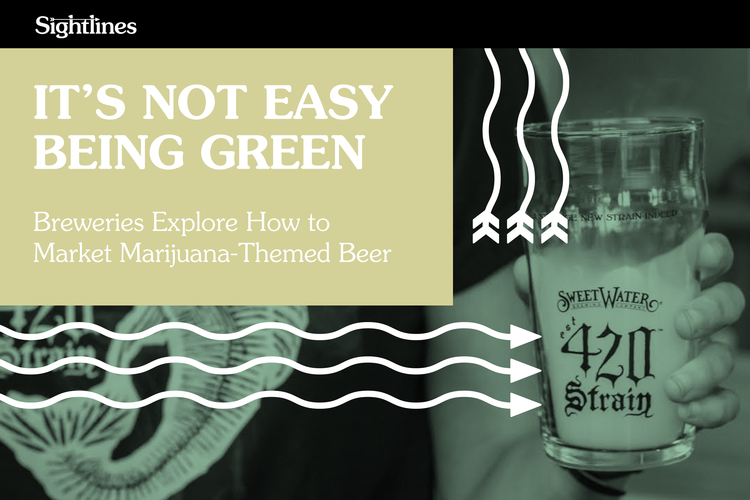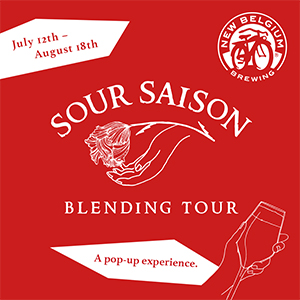Source: goodbeerhunting.com

According to the company’s own self-described “high history,” cannabis is at the core of Lagunitas’ business ethos. This should come as no surprise. The California- and Chicago-based brewery has long packed its story alongside marijuana, rolled into shared points of info that pass from one to the next. It’s a cloud hanging over the brewery since the infamous “St. Patrick’s Day Massacre,” a 2005 drug bust at the Petaluma headquarters that gave birth to Undercover Investigation Shut-Down Ale, all the way up to the recent release of Hi-Fi Hops, a THC-infused, hoppy sparking water. The cannabis connection is a natural part of who Lagunitas is, which just happens to be a brewery, not a dispensary.
"It takes a lot of good weed to make great beer," is something company founder Tony Magee supposedly said 25 years ago, according to company promotions. In today’s industry, however, it raises a question: does it also take a lot of good weed to market great beer?
The branding and communication around Lagunitas has long had a direct tie to cannabis, a brewery that’s even gone so far as sending roach clips in press samples. (Oddly enough, I was once asked to untag Lagunitas from an Instagram post showing a clip in a staged photo with a fake joint.) Aesthetics around themes of “420” and the 1960s are common, but now that pot has a growing cultural cache, Lagunitas no longer has a monopoly on all things weed and beer.
“I think we can all agree that Lagunitas has always had a cannabis culture and persona that kind of pushes the boundaries in a way that makes sense for their brand,” says Jessica Lukas, vice president of consumer insights for BDS Analytics, a market research firm that specializes on the cannabis industry. “But for everyone else, the trick is now doing it in a way that doesn’t feel fake and taking advantage of a trend. It has to be relevant to current consumers while also fitting a brand personality, which is where the challenge is.”
Beer companies getting involved in some form of THC or CBD-laced drink is no longer a surprise. Along with Lagunitas, Molson Coors, Constellation Brands, and Blue Moon creator Keith Villa are all venturing into the space in some form. So is Two Roots Brewing in San Diego. Until now, beer has acted with a sly wink (Oskar Blues’ Pinner Throwback IPA slogan of “Can I be blunt?”) or a punch on the nose (Mt. Shasta Brewing, “Home of Weed Ales & Lagers”). But all of a sudden, with legalization and interest in pot spiking, there’s a capitalistic capitalization to be made. By 2021, BDS Analytics estimates there will be $24.2 billion of cannabis retail sales in North America.
“There’s a lot of conversation about cannabis, hemp, and CBD, and if a brewer can play with the idea of these products and create something that tastes good and consumers are interested in, it’s on trend and part of a big conversation,” she says. “Whether or not these products will last for the long term will be a hot topic of conversation.”
Noting the variety of beers that have entered the market in the past year using cannabis, hemp, or visuals and marketing around it all, Lukas said it all makes sense because breweries are “taking advantage of something that’s hot right now.”
Based on the early success of The Hemperor “Hemp Pale Ale,” New Belgium Brewing hopes a new wave of cannabis-tangential brands lasts longer than a puff of smoke. Between its debut in April and the end of July, the beer sold roughly the same amount in IRI-tracked grocery, convenience, and other stores as single brands like Oskar Blues IPA and National Bohemian, and entire brewery portfolios from Melvin Brewing Co. and Avery Brewing Co.
[Disclosure: New Belgium is an underwriter of Good Beer Hunting’s “Into the Wild” series.]
The beer, adorned with colors of green and a character covered in leaves, was created to recreate hemp terpene flavors. For most people, The Hemperor would be easily recognized for its intense aromatics that mimic hemp’s cannabis cousin, connecting directly to the namesake monarch on the label.
“He’s pretty hemp-forward,” says Bryan Simpson, media relations directly at New Belgium. “There’s a big, flowing beard that looks like dope leaves. By nature of the product, we were looking to push a few buttons and we certainly want to call it what it is.”
And therein is the fine line New Belgium and others have to walk. Make it clear to customers how they should interpret a cannabis-inspired beer, but not go so far over the edge that it becomes kitschy, sophomoric, or even illegal.
For New Belgium’s digital promotions for Hemperor, the company can’t provide any paid advertising on social media sites like Facebook or Instagram, because it would violate terms of service. Simpson says his teams can’t budget for promoted posts “in a marijuana space,” leaving any updates, perhaps fittingly so, for organic growth.
There’s a two-prong approach to discussing the brand. A more serious side focuses on sustainability and legalization efforts for hemp. The more public version is light-hearted, highlighting things like the beer getting banned in Kansas, where the state Alcoholic Beverage Control prohibits hemp seed as an ingredient in alcohol, which garnered extra media hits. Twenty-second YouTube shorts of The Hemperor doling out advice have proven popular, performing as much as eight times better than average posts and playing up the tagline of “behold the dankness.”
Unlike New Belgium’s recent foray into these kinds of communications, SweetWater Brewing Co. has long leaned into marijuana-tinged marketing. It’s 420 Extra Pale Ale—a purposeful indicator toward pot—represents almost 40% of the brewery’s IRI sales. “We’ve never been shy about 420 and the ‘420 lifestyle’ being a part of our DNA, says Brian Miesieski, vice president of marketing for the company.
SweetWater has taken it one more step in 2018, however, to make that connection specific and explicit. G13 IPA, the inaugural beer in what the brewery hopes will be an ongoing series called “420 Strain,” is named after an actual strain of marijuana once regarded as the most sought-after on the planet. Made with terpenes, hemp flavors, and hops, marketing materials plainly state the goal is to smell “like the infamous cannabis strain.”
“For 21 years we’ve spread the 420 gospel to craft beer fans with our flagship Extra Pale Ale leading the way,” the brewery states in press materials. “Now the climate is right for us to further plant that stake in the ground. Introducing 420 Strain, a brand new line of beers that pushes the envelope of brewing and speaks to the 420-friendly lifestyle we’ve always lived and loved.”
Photos for the beer and its apparel are shrouded in smoke. Its slogan is "a strange new strain indeed." The only thing about the beer that doesn’t outright scream “weed” is the use of a ghostly version of SweetWater’s iconic fish, nicknamed internally as “Bones the Trout.” Although even that has a certain Grateful Dead kind of feel.
“As [cannabis] becomes more prominent in pop culture and accepted and less taboo, it makes sense for a beverage alcohol company to tap into that lifestyle,” Miesieski says.
The trick to it all, adds Tucker Berta Sarkisian, director of communications, is tracking how it all moves the brewery’s “authenticity meter.” Because aspects of marijuana have long been associated with SweetWater, packing in additional references and ties to a brand should feel like a natural extension for fans of the brewery.
“First and foremost, it’s an incredible beer with a cool concept,” she says. “But the campaign and concept are a bonus because they’re honest to who we are. That’s how we stand out.”
The proposition of authenticity may be true for SweetWater, but it’s bound to seem less unique in the coming years. Among the changes in how breweries might make or market a beer in its relation to marijuana, the most important may be America’s acceptance of the drug itself. In recent polling by Gallup, marijuana was cited by survey respondents as the least harmful substance among a list that included cigarettes, chewing tobacco, cigars, a pipe, and e-cigarettes. Another poll showed that 65% of respondents said smoking marijuana was morally acceptable, nearly identical to 64% who now support the legalization of cannabis, a percentage that has more than doubled in the last 20 years.
As perception has changed, it can be hard to believe the U.S. is just 80 years removed from the propagandist sensationalism of Reefer Madness, a movie released in 1936 purposely to terrify citizens at the use of marijuana. In today’s marketplace, 72% of cannabis users also consume alcohol, according to BDS Analytics, and 82% of that figure are also beer drinkers. Not only is society at-large more accepting of conversations and use of pot, but the crossover potential is only getting stronger.
“I think there’s a lot of opportunity out there utilizing hemp and cannabis for a lot of these companies,” says Jessica Lukas, vice president of consumer insights for BDS. “I continue to reiterate this should not be an ‘if you can’t beat them, join them’ conversation. It’s a strategic conversation for a business, consumers, and potential customers.”
Craft beer consumers are cannabis consumers and vice versa, Lukas says, noting that craft beer drinkers also over-index in that connection. What this all leads to in the long run depends on what happens with the legalization of pot state-by-state and, most important, federally. Lukas notes that an increase in weed-themed beers is just a start. The real end game isn’t just to have a hemp beer or something that mimics marijuana.
“This is the start of a bigger conversation down the road of including THC, CBD, or terpenes,” Lukas says. “A lot of companies don’t want to touch this until federal legalization happens, so others might as well take advantage of what they can with safer ingredients that play to the conversation in the marketplace.”
Until then, craft beer seems determined to pass to the left as a way to share a growing market—even if it’s not quite the real thing.



No comments:
Post a Comment